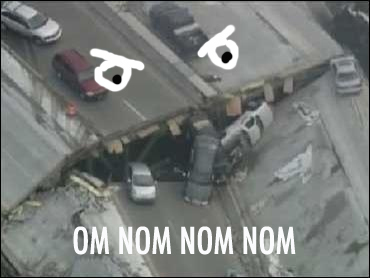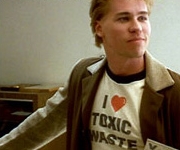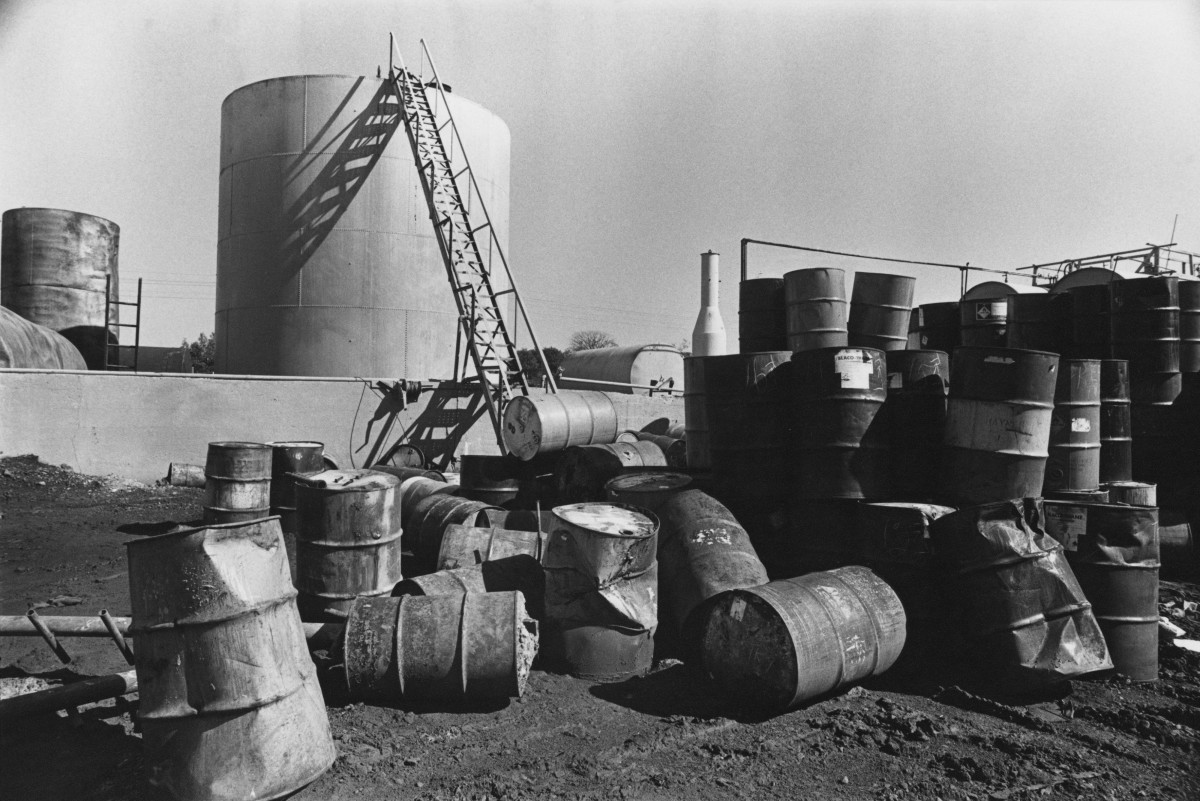Radioactive Waste Now Hidden in Everyday Household Products
Hide the Ooze - Life imitates art, as recycled radioactive waste ends up in consumer products, roads, schools and... playgrounds. Apparently even corrupt CEO's watch The Simpsons.
Radioactive materials from nuclear weapons facilities are being released to regular landfills and could get into commercial recycling streams, finds a report issued by the nonprofit Nuclear Information and Resource Service, NIRS. Radioactive scrap, concrete, equipment, asphalt, plastic, wood, chemicals, and soil are placed in ordinary landfills, researchers learned.
"People around regular trash landfills will be shocked to learn that radioactive contamination from nuclear weapons production is ending up there, either directly released by DOE or via brokers and processors," says lead author Diane D'Arrigo, NIRS' Radioactive Waste Project director. "Just as ominous," she said, "the DOE allows and encourages sale and donation of some radioactively contaminated materials."
This free release opens up the potential for the materials to enter the recycling stream to make everyday household and personal items or to be used to build roads, schools, and playgrounds.
The NIRS report tracked the laws, guidance and technical justifications that DOE uses to rationalize allowing commercial businesses and recreation areas - places unprepared to handle radioactivity - to recycle and reuse these materials.
"DOE is ignoring public opposition to unnecessary exposures and releasing radioactivity even though the U.S. Congress revoked such release policies," said Mary Olson, director of the NIRS Southeast office and a co-author of the report. "DOE is using its own internal guidance to allow radioactive weapons wastes out of control, claiming the doses to people will be 'acceptable' even though they are not enforced or tracked," Olson said.
This dispersal of radioactive materials is being done without comprehensive complex-wide tracking, without routine public reporting of the releases from each site and processor and usually without independent verification that it is within the DOE's self-imposed limits, the NIRS researchers found.
"As long as DOE and other nuclear waste generators can slip their contamination out — letting it get out of control — On purpose — there is really no limit to the amount of additional radiation exposure members of the public could receive," D'Arrigo concluded.
"Only an informed, outraged public can force DOE and agreeable states to shift the goal from dispersal to isolation of radioactive waste."
On September 30, 2005, the Department of Energy announced that it had accomplished "a major milestone in environmental cleanup with the safe disposition of over one million cubic feet of legacy waste," from the Oak Ridge Reservation. This volume equates to a football field covered more than 30 feet high. The waste consisted of radioactive scrap metal, contaminated soil, construction debris, organic liquids, waste water and sludge residue, the DOE said.
"Bechtel Jacobs Company, LLC, the department’s environmental cleanup contractor, completed the project safely and on-time," the DOE said. But it is where the radioactive material goes when it is removed from the DOE sites that NIRS researched. By permitting radioactive materials to go directly to unregulated destinations and to licensed processors who subsequently release it, DOE is enabling manmade radioactivity to get out into the open marketplace, landfills, commercial recycling and into everyday consumer products, construction supplies and equipment, roads, piping, buildings, vehicles, playgrounds, basements, furniture, toys, zippers, and personal items without warning, notification or consent, NIRS researchers discovered.

Europe already shunning U.S. goods as too toxic
Europe has launched stringent new regulations that require companies seeking access to their lucrative markets eliminate toxic substances and manufacture safer electronics, automobiles, toys and cosmetics. International markets are moving toward a European model of insisting on environmental and consumer safety.
Dangerous chemicals have been identified via the European Union’s 2007 Registration, Evaluation, Authorization and Restriction of Chemicals (REACH) law, which requires the disclosure of all chemicals sold in the EU in quantities of more than one metric ton per year. Of the 267 chemicals on the potential REACH list, compiled by the International Chemical Secretariat in Sweden, only a third have ever been tested by the Environmental Protection Agency (EPA), and only two are regulated in any form under US law. According to the EPA itself, only five percent of all chemicals in the US have undergone even minimal testing for their toxicity or environmental impact. An estimated forty-two billion pounds of chemicals enter American commerce daily, while fewer than five hundred of those substances have undergone any substantive risk assessments.
Between 1996 and 2006, the industry contributed $35 million to federal election campaigns, and spends between $2 million and $5 million each year on lobbying in Washington. This interest also spent a significant amount on lobbying at the state level. Consequently, new EPA requirements include the “costs to industry” in determining whether a substance presents an “unreasonable threat to public health” and that the “least burdensome regulation” be imposed on industry. As a result of the contrast between US deregulation and the spreading European model of regulation, the US has become the dumping ground for toxic toys, electronics and cosmetics. We produce and consume the toxic materials, from which other countries around the world are protected. Among other things, this means that soon our economy will suffer even more than it already is, because most of the world will refuse to buy our goods.

U.S. corporations seeking to import foreign nuclear waste
Meanwhile in what's likely to be the start of a trend, the largest nuclear waste firm in the U.S. is aggressively seeking to bring in 20,000 tons of radioactive waste in from Italy to the U.S.. The rather euphemistically-named "EnergySolutions" (a limited liability company, amusingly enough) wants to help Italy with its renowned waste problem by bringing 20,000 tons of its radioactive waste here - where radioactive waste is now released and recycled back into U.S. products unchecked. If the deal is approved by the Nuclear Regulatory Commission, it would be the largest amount of radioactive waste ever imported into the U.S..
EnergySolutions has agreed to limit 5% of their storage space to foreign radioactive waste, but they're already processing 36 states' waste and 90% of the low-level radioactive waste in the U.S.. Incidentally, they're also a major contributor to the Republican Party in Utah (the vast political majority in the state).
For its part, the U.S. Nuclear Regulatory Commision says that it won't halt the plan. In a neat twisting of facts into irrelevancy it also says that says that it lacks the authority to restrict foreign radioactive material importation, and adds that they don't "distinguish between domestic and foreign waste." Meaning, apparently, that they remain disinclined to begin making that distinction now. Completing its' spin, the NRC adds that, "as long as the material can be imported safely and someone is willing to accept it, the commission can't keep the waste out." - implying that the current safety and standards of nuclear disposal are rock-solid and above reproach, which as you've already read is far from the truth indeed.
The talks began after a federal judge ruled against an effort by western states to block the import of the nuclear waste. Former Gov. Jon Huntsman objected to bringing the waste to Utah and used a regional compact created by Congress that manages low-level radioactive for eight states to block it.

EnergySolutions said in February, 2009 that it would offer Utah 50
percent of its net revenues from the disposal of foreign nuclear waste.
Huntsman scoffed at the proposal, saying the long-term impact wouldn't
be worth a temporary financial windfall. Since then, a federal judge
has ruled that the regional compact doesn't have the authority to
regulate the facility and keep the foreign waste out. The state and
compact have appealed the decision.
Huntsman resigned in
August of 2009 to become U.S. ambassador to China, leaving Herbert, who
had been his lieutenant governor, in charge until a special election in
2010. "We have been very consistent on saying that we don't think that
we want to have foreign waste imported into Utah. And the reason for
that's very simple, we have plenty of domestic waste," Herbert said at
the time.
On Friday, September 4th 2009 in response to an
environmentalist group's urging Utah's governor to publicly reject
EnergySolutions' offer, the Governor's spokesperson stated that Herbert
is still against bringing in the low-level Italian waste, and is
continuing to stake that position in the courts.
EnergySolutions appears to be continuing to press for a favorable outcome overriding the Utah governor's decision, and after prevailing in a round in federal court weeks ago EnergySolutions said on the same day that it was in "settlement discussions" over the plan for the waste.

Above: Not a pirate.
Below: Also not a pirate.

When is a pirate not a pirate?
With all this going on, what will the U.S. look like in a few years? We have only to look to the Somalian pirates that recently made the news cycles - because they're the last guys to have been stuck with this nuclear waste Hot Potato. When the government of Somalia collapsed in 1991, foreign interests including Italy seized the opportunity to begin looting the country’s food supply and using the country’s unguarded waters as a dumping ground for nuclear and other toxic waste. Among them, Italy - which you'll recall is the country whose nuclear waste is trying like heck to get dumped in the U.S. now, instead of Somalia.
Why? Well, in 2004 a tsunami hit Somalia and churned up the radioactive waste other countries like Italy dumped along its shores. The United Nations Environment Program reported that the typhoon washed rusting containers of toxic waste onto the shores of Puntland in northern Somalia... when the hard evidence made it impossible to look the other way and avoid the situation anymore.
Nick Nuttall, a United Nations Environment Program spokesman, told Al Jazeera that when the barrels were smashed open by the force of the waves, the containers exposed a “frightening activity” that had been going on for more than a decade. “Somalia has been used as a dumping ground for hazardous waste starting in the early 1990s, and continuing through the civil war there,” he said. “The waste is many different kinds. There is uranium radioactive waste. There is lead, and heavy metals like cadmium and mercury. There is also industrial waste, and there are hospital wastes, chemical wastes — you name it.”
Nuttall also said that since the containers came ashore, hundreds of residents have fallen ill, suffering from mouth and abdominal bleeding, skin infections and other ailments. Pay attention to the symptoms, because we'll be seeing them more and more frequently in the U.S. now that our consumer products will be radioactive.
“What is most alarming here is that nuclear waste is being dumped. Radioactive uranium waste that is potentially killing Somalis and completely destroying the ocean,” he said.
According to the High Seas Task Force (HSTF), there were over 800 illegal, unreported and unregulated (IUU) fishing vessels in Somali waters at one time in 2005, taking advantage of Somalia’s inability to police and control its own waters and fishing grounds. These IUUs from various other countries poach an estimated $450 million in seafood from Somali waters each year.
Ahmedou Ould-Abdallah, the UN envoy for Somalia, says the practice helps fuel the eighteen-year-old civil war in Somalia, as companies pay Somali government ministers and/or militia leaders to dump their waste. “There is no government control . . . and there are few people with high moral ground . . . yes, people in high positions are being paid off, but because of the fragility of the Transitional Federal Government, some of these companies now no longer ask the authorities—they simply dump their waste and leave.”
Surprisingly, the UN has disregarded its own findings, and has ignored Somali and international appeals to act on the continued ravaging of the Somali marine resources and dumping of toxic wastes. Violations have also been largely ignored by the region’s maritime authorities. This is the context from which the men we are calling “pirates” have emerged. Everyone agrees they were ordinary Somali fishermen who, at first, took speedboats to try to dissuade the dumpers and trawlers, or at least wage a “tax” on them. They call themselves the Volunteer Coast Guard of Somalia.
Instead of taking action to protect the people and waters of Somalia from international transgressions, the UN has responded to the situation by passing aggressive resolutions that entitle and encourage transgressors to wage war on the Somali pirates. The UN Security Council (a number of whose members may have ulterior motives to indirectly protect their illegal fishing fleets in the Somali Seas) passed Resolutions 1816 in June 2008, and 1838 in October 2008, which “call upon States interested in the security of maritime activities to take part actively in the fight against piracy on the high seas off the coast of Somalia, in particular by deploying naval vessels and military aircraft . . .”
Both NATO and the EU have issued orders to the same effect. Russia, Japan, India, Malaysia, Egypt, and Yemen, along with an increasing number of countries have joined the fray. Now the international community can continue its poaching and nuclear dumping with impunity.
At the ICGS Anti-Piracy meeting in Cairo on May 30 2009, Egypt and (not surprisingly) Italy were two of the loudest countries calling for severe punishment of the Somali fishermen pirates. When the ICGS met in Rome on June 10, 2009, two Egyptian trawlers full of fish illegally caught in Somali waters and an Italian barge that had been towing two huge tanks suspected of containing toxic or nuclear waste were being held in the Somali coastal town of Las Khorey by the local community, who invited the international experts to come and investigate these cases. So far, the international community has not responded to the Las Khorey community’s invitation to the best of my knowledge.
Perhaps Johann Hari of the Huffington Post put it best when he said, "If we really want to deal with piracy, we need to stop its root cause — our crimes — before we send in the gun-boats to root out Somalia’s criminals."

Summary - Where does this leave us?
While Hari's approach may be a matter of common sense and sanity, an agenda for profit on the part of international corporations and government officials the world over has taken precedence. It doesn't speak very favorably of our representatives' opinion of Americans that they would use the moral lapse they're choosing in Somalia... using our military and tax dollars to do it, and scattergunning "pirate" propaganda at us through the news media. Nor is it particularly encouraging to think that if the corporations and nuclear regulatory agencies have their way, the U.S. will become the next dumping ground for the world's toxic nuclear waste right into the consumer products we use. Not only does that indicate that in the mind of the average U.S. representative the American citizen exists to serve exactly the same purpose as a pimple, it's creepy to think of what will happen as we all start getting radiation sickness and the economy takes another nosedive because the rest of the world refuses to buy our products.
But while it's very easy and comfortable to place blame on government officials or rich CEOs, it would be a lot more accurate (if uncomfortable) to take a look at just who is enabling them to continue doing all this: the average American citizen. By not holding our representatives accountable for actually representing our will, we're not only not protesting what they're doing but most Americans are actively subsidizing it with their tax dollars. Our collective moral and political apathy is finally killing us - literally. The cows are coming home to roost.
So... who's the real pirate? Just take a look around you. It's the average American citizen. When does all this corporate and political abuse stop? Whenever we stop it. We can stop it any time we want to - countless options exist today, from creating online petitions, to contacting our governors and representatives, to opting not to pay income taxes and subsidize the problem, to using commercial liens to demand accountability of people who are wronging us, to buying guns, to promoting information and awareness online and using social bookmarking sites to build a network of activism. What happens until we take care of these problems rather than generating them? We just get sicker and sicker, and broker and broker. But it's always up to us.
No rush.







